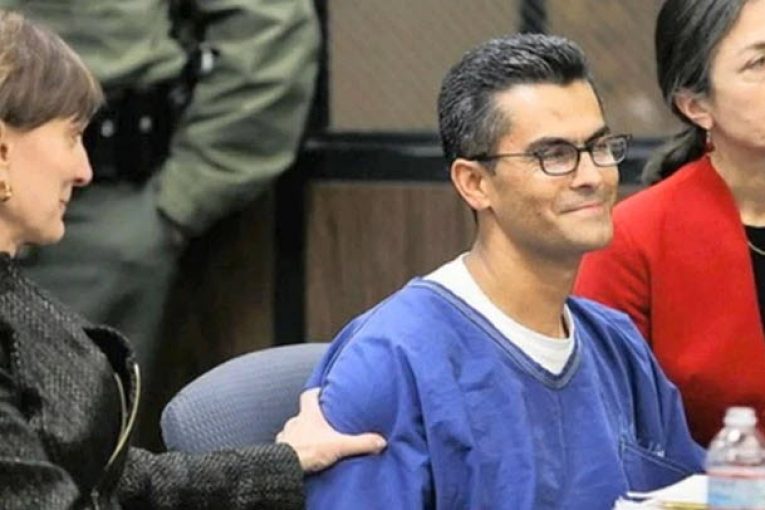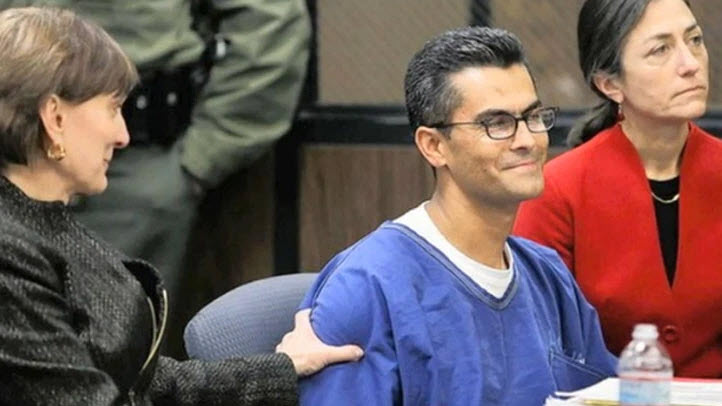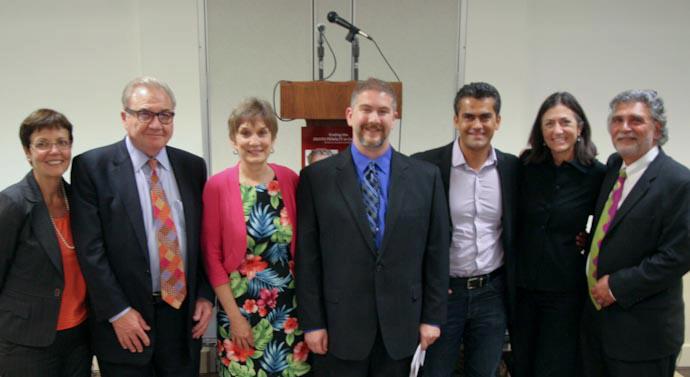

By Nancy Martinez
The second subseries of Netflix’s “The Innocence Files” focuses on two wrongful convictions caused by mistaken witness identifications.
Episodes Four and Five investigate the case of Franky Carrillo, who was convicted of a gang-related drive-by shooting that resulted in the death of Donald Sarpy. The Northern California Innocence Project (NCIP) worked to reverse his conviction after uncovering inconsistencies with six eyewitness testimonies. Episode Six dissects the mistakes that led to the rape assault conviction of Thomas Haynesworth. Both episodes discuss the key problems that lead to unreliable witness testimonies.
Episode Four
The Witness: The Murder of Donald Sarpy
Franky Carrillo was 16 years old when he was accused of a gang-related drive-by shooting that resulted in the death of Donald Sarpy.
Carrillo was first contracted into the overpowering Latino gang in Lynwood, the Lynwood Varrio Young Crowd, as a result of his sister being married to existing leaders and gang members.
Brentford Ferreira, past Deputy District Attorney of L.A. County, and Ellen Eggers, attorney of Carrillo’s legal team, explain the brutal rivalry between Latino gang Young Crowd and another local gang known as Neighborhood Crips, also referred to as “N-Hood.”
This rivalry between the gangs often led to drive-by shootings and violent crime in impoverished communities, leading to thousands of deaths.
Scott Turner, a member of Neighborhood Crips, and Dameon Sarpy, son of Donald Sarpy, recall the night of Jan. 18, 1991, beginning when a car driven by Hispanics passed by them and their friends who were hanging outside of Sarpy’s home. Dameon’s father was interacting with his son’s group of friends when the car drove by a second time and fired shots. Donald Sarpy was fatally wounded on the side of his body.
The L.A County Sheriff’s Department that investigated the murder of Donald Sarpy strongly believed the murderer was a member of the Young Crowd gang. Their investigation of the murder led to the several witness testimonies that pointed to Franky Carrillo as being the drive-by shooter. On Jan. 24, 1991, Franky Carrillo was arrested at his home by the sheriff’s department.
Franky spent 92 days in juvenile hall, during which he was attacked several times by guards who were friends with Donald Sarpy. Violence during his incarcerated time continued for being accused of a crime he did not commit.
Craig Ditsch, the gang-related sheriff investigator, questioned Scott Turner who claimed he was able to identify the perpetrator. Ditsch provided Turner with a book of pictures of individuals who were known to be associated with local gangs. After seeing hundreds of pictures, Turner identified Franky Carrillo as being the drive-by shooter.
To verify the identity Turner had selected, Distch further provided Turner with a secondary line-up known as a “six-pack.” From these six more options of individuals, Turner again selected Frank Carrillo.
Ditsch asserted his confidence of Turner’s selection in his statement during trial testimony: “I couldn’t tell you how few cases I have, where they go through the gang book and pass a hundred pictures and still pick a guy out…and then to pick him out of a six-pack of five other similar appearing individuals, it doesn’t happen.”
According to Ditsch, this unique circumstance pointed to the obvious guilt of Franky Carrillo. However, this also suggests the very low reliability of lineups and photo-identifying methods that  sheriff and police department continue using nationwide today.
sheriff and police department continue using nationwide today.
Ph.D. Gary L. Wells, an eyewitness expert, explained how eyewitness testimony became unreliable as cities grew in population. As populations grew, so did inconsistencies with eyewitness testimony. Wells argues that the problem with providing a witness with lineups of individuals is that at some point the appearance of one individual will match enough significant characteristics of the actual offender and people will end up accusing the wrong individual.
During Carrillo’s preliminary hearing, Scott Turner identified Franky Carrillo as being the drive-by shooter. Later, during Carrillo’s trial on June 22, 1992, Franky Carrillo and Scott Turner had a conversation prior to Turner’s witness testimony in which Turner revealed to Carrillo that he knew Carrillo was not the shooter and would testify that he did not see the shooter.
However, the other five witnesses that were present the day of the shooting, identified Franky Carrillo as the shooter. During his witness testimony in the trial, Scott Turner recanted his statement from the preliminary hearing and informed the court that Sheriff Ditsch had, in fact, been suggestive of Turner’s picture as being the correct one.
As a result of this new statement, Turner also unveiled that Ditsch and he had a prior witness-identifying relationship. Turner had been previously used by Ditsch to identify suspects in other cases. During the identification of Carrillo, Turner claimed he was accustomed to identifying whomever the sheriffs and investigators suggested to him.
Prosecuting District Attorney, Mary Ann Escalante, argued that all the other five witnesses had been reliable and, as a result of facing prison time, Scott Turner may have recounted his testimony to avoid violence in prison. Escalante supported her decisions in prosecuting Carrillo with Franky’s own testimony, in which he self-identified as a member of Young Crowd.
Franky Carrillo testified during his trial that on the Friday evening of Jan. 18, 1991, he had been home where he had done house chores and worked on his homework. Escalante argued that Carrillo must have been lying about his alibi because, as a gang member, there was no way that Carrillo would have been doing his homework or chores on Friday night.
On June 30, 1992, a jury found Franky Carrillo guilty of the murder of Donald Sarpy. During his sentencing, defense attorney Yamamoto informed the court that there was a witness whose testimony may alter Carrillo’s case.
Oscar Rodriguez, a member of Young Crowd, was coming forward with information related to the drive-by shooting Carrillo was found guilty of. Rodriguez had information that excluded Carrillo as being involved during the shooting.

Episode Five
The Witness: The Trial of Franky Carrillo
Prior to being condemned for two consecutive life sentences for the murder of Donald Sarpy, there had been an initial trial for Franky that resulted in a mistrial.
The unreliability of witnesses who had contradicting information on details of the crime scene led to the first mistrial. After this initial trial, the prosecution had the witnesses sharpen their testimony to ensure their confidence would convey to the jury during the second trial.
Prior to the sentencing for the second trial, Oscar Rodriguez had come forward with information that could exclude Franky from the shooting. However, with the opposition of DA Escalante, the court did not allow his testimony into the trial and Oscar’s cooperation was lost.
In 2006, Ellen Eggers, an experienced attorney, became involved with Franky’s case after meeting with him as a request from his GED instructor.
Eggers reached out to the NCIP’s director, Linda Starr. Two years worth of investigation into Franky’s case finally led to the discovery of several mistakes that could have led to his exoneration.
Six eyewitnesses recounted their trial testimony as a result of the new investigation. Inconsistencies were found within their testimonies, and coercive suggestions on behalf of the sheriff’s department were believed to have been what led to their incriminating testimony.
During the initial murder investigation by the sheriff’s department, there was only one eyewitness who was contacted by the investigators on the day of the incident. After six months of the singular witness, the sheriff investigators reached out to the other five witnesses. Throughout these six months, the order of lineups presented to the first witness, Scott Turner, did not change. This would later be assumed to be the cause of the five witnesses pointing to Franky as being the shooter.
Dameon Sarpy, son of the victim, had been very reluctant to recount his witness testimony, while the other witnesses had adjusted their testimony to fit their uncertainty during the night of the murder.
After Ellen Eggers was able to sit with Dameon and explain newfound inconsistencies with the case, Dameon testified to Eggers that his testimony had been a reflection of Turner’s testimony. He did not see the shooter; instead, he testified to whomever Turner had initially picked out.
After gaining significant momentum in the NCIP’s investigation, the Lynwood’s Sheriff Department began to reinvestigate their case as well. According to Eggers, the sheriff”s department began harassing the community to ensure that eyewitness testimony would not change.
Through NCIP’s investigation, Carrillo was able to submit a habeas corpus motion arguing that he did not get a fair trial due to false witness testimony, and argued third-party culpability.
During Carrillo’s final hearing, DA Mary Ann Escalante emotionally expressed her feelings regarding the news of Dameon Sarpy confirming that he had never seen the shooter. Escalante faced the possibility that Carrillo may have not committed the murder of Donald Sarpy; however, she was was perceived to be accepting of this new realization.
In order to get Carrillo’s conviction reversed, Carrillo’s defense attorneys had to recreate the crime scene and place Judge Bacigalupo where the witnesses were in place, in order to prove that no identification could have been possible. To the support of their case, during the recreation, no identification of a car passenger was made.
During his closing statement, District Attorney Brett Fereira surprisingly asked the court to grant Franky’s habeas corpus motion due to the unreliable witness testimony. In 2011, the Superior Court of L.A County overturned his conviction for the murder of Donald Sapry.
In 2016, Franky received a 10.1 million dollar settlement for the 20 years he spent wrongfully convicted in state prison. Franky currently strives to advocate for reformative policy that will prevent future misidentification testimony resulting in wrongful convictions.
L.A County’s Sheriff’s Department has since refused to comment on this case and Oscar Rodriguez pleaded the Fifth Amendment following Franky’s overturned conviction in 2011. The murder of Donald Sarpy remains unsolved; nevertheless, Dameon Sarpy continues to fight for justice in his father’s murder.
According to the documentary, 77,000 people are tried in court as a result of eyewitness testimonies.
Since 1992, the Innocence Project has worked on reformative legislation that has been passed in 24 states.
Episode Six
The Witness: Making Memory
Episode Six of Netflix’s “The Innocence Files” aims to answer how memory becomes so distorted and explores the journey of a man who spent 25 years in prison for a crime he did not commit.
As violent crime rates rose in Richmond, Virginia, during 1983 and 1984, there was a series of violent acts committed by one alleged suspect on white women of the community.
On Jan. 3, 1984, Janet Burke was sexually assaulted by a black male after she arrived at her workplace. The suspect threatened her with a knife.
During her attack, Janet fully committed herself to remember every detail of the man, including his facial features, height, and clothing details. The suspect was wearing an open-faced mask that allowed her to see his facial features.
A series of four assaults on white women followed Janet’s rape between Jan. 3, 1984, and Feb. 1, 1984. The assaults ranged from rape to attempted kidnapping.
On Feb. 6. 1984, the police department had a suspect in custody. Janet was shown multiple pictures of possible suspects. Janet identified 18-year-old Thomas Haynesworth as her attacker.
Prior to Janet identifying Thomas, he became a suspect after being reported by the third assault victim when she spotted him at a grocery store and believed he resembled her attacker.
By the time Thomas was indicted for assault charges, multiple women came forward and asserted their confidence that he was their attacker. At 18, Thomas was facing multiple charges of which he could not defend himself because of solid eyewitness testimonies.
On July 12, 1984, the first day of Thomas’ trial began. His family testified to his alibi. According to his mother, Thomas was home while she was pulling down the Christmas tree. Though multiple witnesses supported his alibi, the fact that his mother was his primary witness was not very strong for his case.
After being convicted of Janet’s rape, Thomas was later convicted of two more rapes.
A second series of attacks followed Thomas’ conviction with the new suspect regarding to himself as the “Black Ninja” to his victims. His MO consisted of carrying a knife along with other details similar to Thomas’ case. However, rather than looking into the accuracy of Thomas’ convictions, these other assaults were seen as distinct cases that were further proof of black men preying on white women in this area.
These key details uncover the dark facts about the relations between black and white communities. According to historian Julian Maxwell Hayter, Ph.D., these threatening accusations of random black men were a result of people being unable to distinguish black faces.
After a confrontation between Thomas and Leon Davis, another convicted individual in the same prison as Thomas, Thomas believed Davis may have been responsible for the rapes he was being accused of.
Leon Davis had been convicted to four life term sentences with an additional 100 years in prison for several accounts of rape.
Thomas informed investigators and news reporters of his beliefs but all neglected to look further into his claims.
On Feb. 17, 2009, after 25 years of being imprisoned, Thomas was informed that DNA testing would be conducted regarding his case. After the testing, Thomas was successfully eliminated as being the source of the DNA in the rape kit. In addition, Leon Davis was found to be the source of the DNA.
The key mistake in Janet’s identification of Thomas was suggested to be that, prior to identifying Thomas in the third line up, she had been informed that they had arrested a suspect and she felt it was her responsibility to just pick someone out.
Cross-race identification is the suggested main underlying cause of the misidentification of Thomas and Leon. Black individuals can more easily distinguish black faces than white individuals. Because all of the victims were white women, it was very difficult for them to distinguish any real differences in appearances. These mistakes may not be a direct result of racial prejudice—however, the connection between the two is still outstanding. Segregation policies of the 19th and 20th centuries clearly still affect relationships between white people and people of color, with further detrimental and oppressing of non-white populations.
As a result of the Innocence Project’s Shawn Armbrust and Peter Neufeld, six appellate court judges found Thomas’ claim of his innocence to be correct and his conviction was overturned.
Thomas Haynesworth was exonerated after spending 30 years being wrongfully convicted. Since the overturned conviction, Janet Burke has worked alongside Thomas Haynesworth to advocate for awareness of issues that arise with eyewitness testimony.
Seven hundred people have been exonerated of their convictions in which misidentifications have been a contributing factor.
Mistaken eyewitness identifications are the leading cause of wrongful convictions, proven by DNA evidence.
Franky Carrillo and Thomas Haynesworth were both robbed of their youth when they were victims of wrong eyewitness testimony. Their story, along with the stories of 700 others, should stand to be cautionary tales that should propose better legislation to protect communities nationwide. By imprisoning wrong individuals, we are not only affecting their lives, but we are also putting the rest of society at risk as the true perpetrators remain free. The system must be changed now as wrongful conviction cases continue to pile up due to mistaken eyewitness testimony.
To sign up for our new newsletter – Everyday Injustice – https://tinyurl.com/yyultcf9





